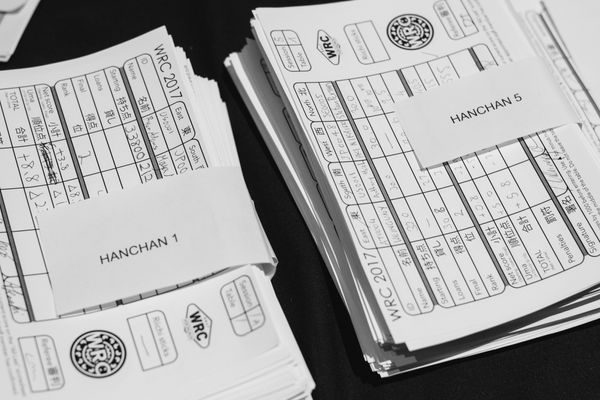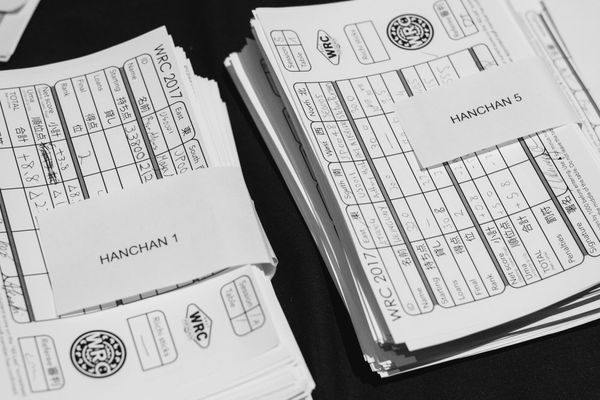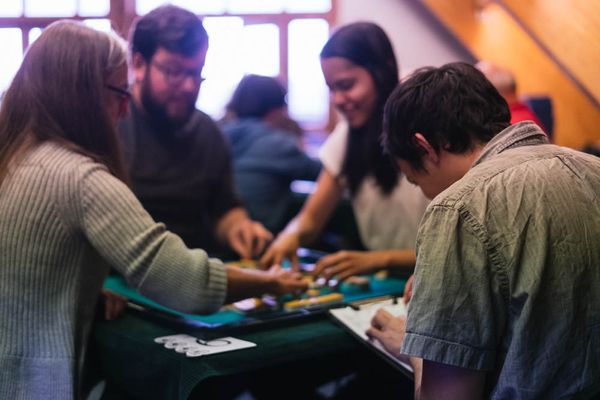Mahjong Teaching Method, Tibet Rules
A couple weeks ago, the USPML hosted a Mahjong booth at PAX EAST. Over the course of three days, with only space for four mahjong tables (three used for teaching), we ended up teaching over 350 people through one hour “How to play Mahjong” sessions. Throughout all of our teaching at PAX East, the biggest success came from a certain teaching style we learned from Benjamin Boas (Author and Mahjong playing American who lives in Japan), called the Tibet Rules. The beauty in these rules is that not only do they effectively teach people how to play mahjong, but also gets them quickly immersed in a game that they can immediately play and get better at, without having to jump through a set of convoluted rules. At PAX East, the large majority of the people that came back for intermediate and advance lessons, as well as those who came to buy mahjong sets, lesson books, and find out more information about mahjong after their lessons, came from the tables using a variety of these rules to teach. The following is the rules that Ben sent us:
1st major milestone — Tibet Rules
- No chiing
- No honors
- no yaku
- no nothing
The Steps
- 4 tiles one suit
- 7 tiles one suit
- 7 tiles two suits
- (10 tiles two or three suits)
- 13 tiles two suits
- 13 tiles three suits
Tibet Rules
Don’t even make the wall. Take wall-building and all cosmetic stuff out as well as all ritual stuff. It’s intimidating and silly. Leave all the tiles face-down in the center, when it comes to dealing and rebuilding, have them just pull from a pile.
Start them off with four-tiles, only one suit (probably pin – always pin -> sou -> man). Show everyone that there’s four of each and what each tile is. Four tile mahjong is a pair and then a set. Explain what the sets can be. Have everyone take four tiles, do it open, walk them through what happens. When someone wins, congratulate them and go through their hand to show why they won. Ask everyone if the winning tile was the only tile they could have won on. This lets them start to see the basic patterns. Get them starting to consider the multiple ways their hand can be broken down. It’ll show them the things that can be interesting about the game right away. What’s interesting is the many ways to arrange the tiles in your hand. What’s interesting is that the tiles interact with each other in more complicated ways than you think. The reason that it goes deep is because of the tile structure – this is what makes it a good game, this is what keeps people engaged in the game, this is what makes the game interesting.
Teach them to do “ron” and “tsumo” from the beginning. This gets them used to using foreign terminology. It sticks because only the winner gets to say them so that helps things stay exciting. Get them to sound excited. It makes them want to win and it makes them remember the right words to say.
This completes one cycle. Keep going until everyone seems to have an understanding of what’s going on. Then you move up to 7. Keep going, and introduce the new patterns. Let them scale up this way. Keep it one suit, which actually gets rather hard. People will think that introducing the second suit makes it harder but it actually makes it easier. By the time they can handle seven they’ll feel that Mahjong is hard. But they’ll do very well when you introduce a second suit, which will encourage them, since it’s nowhere near as hard as it looks.
Then depending on how people are doing, go to 10 tiles 2 suits or 13 tiles 2 suits.
The very last step is to introduce Pon, which is “Tibet rules” and allows them to play on their own. At that point they’ll be able to win fairly easily on their own. If you can keep the dedicated teacher there and they’ll still maintain interest Ben recommends not introducing Pon. The more dependent you can make them on their own draws they better a player they will be.
Another house rule. People will talk during the game, that’s fine. Talk about anything you want as long as it’s not your turn – no talking during your turn. “It’s totally fine to think about what you want to discard but not what you want to draw”. The pace of the game depends on everyone paying attention so there’s no forgiveness for drawing late. Stop the conversation and point at the person whose turn it is.



